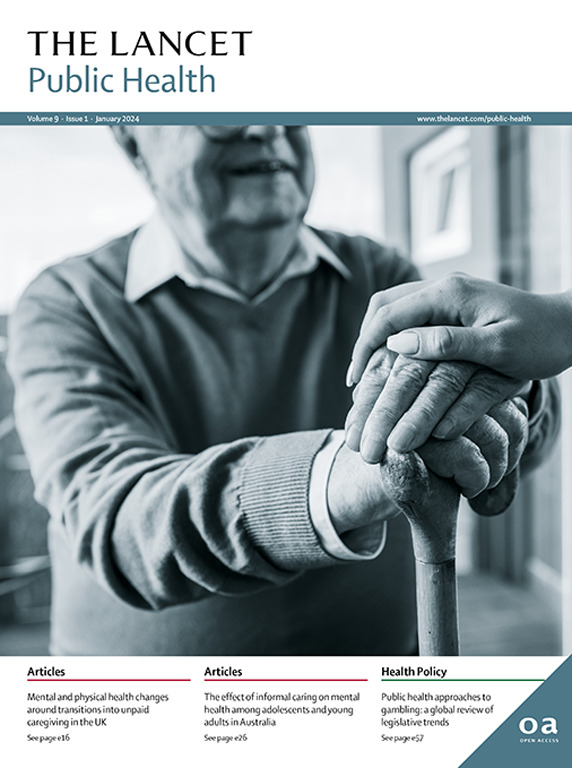1990-2021年东南亚国家联盟(东盟)各国心血管疾病的流行病学和负担:《2021年全球疾病负担研究》的结果
IF 25.2
1区 医学
Q1 PUBLIC, ENVIRONMENTAL & OCCUPATIONAL HEALTH
引用次数: 0
摘要
东南亚国家联盟(ASEAN)在过去三十年中经历了重大的流行病学变化,其特点是心血管疾病负担日益加重。这项研究提供了东盟各国心血管疾病的流行病学概况。方法作为2021年全球疾病、伤害和风险因素负担研究的一部分,我们评估了1990年至2021年10个东盟成员国(文莱、柬埔寨、印度尼西亚、老挝、马来西亚、缅甸、菲律宾、新加坡、泰国和越南)按年龄、性别和地区分层的12种心血管疾病的患病率、死亡率、生命损失年数、残疾生活年数和残疾调整生命年(DALYs)。我们检查了与心血管疾病相关的主要危险因素的贡献。使用不同的数据源和元分析建模技术来综合数据并为每个指标生成一致的估计。研究发现,2021年,东盟共有3680万(95%不确定区间为34.4 - 38.8)例心血管疾病流行病例和166万(1.51 - 1.80)例心血管疾病死亡。DALYs总数为4240万(38.4 - 46.2),心血管疾病成为该地区疾病负担的主要原因。与1990年相比,患心血管疾病的人数增加了14.1%(14.4 ~ 15.5),而年龄标准化患病率上升了2.5%(14.4 ~ 6.6)。年龄标准化患病率最高的是马来西亚,其次是印度尼西亚。年龄标准化患病率最高的前3位心血管疾病是缺血性心脏病(每10万人2070·6[1831·3-2358·2])、下肢外周动脉疾病(每10万人1380·8[1189·8 - 1598·7])和脑卒中(每10万人1300·6[1230·5-1375·4])。老挝的年龄标准化死亡率最高(每10万人死亡410·9人[337·2-485·9])。大多数心血管疾病负担归因于高收缩压、饮食风险、空气污染、高低密度脂蛋白胆固醇和吸烟,高BMI和高空腹血糖迅速上升是归因因素。2021年,心血管疾病仍然是东盟死亡和发病的主要原因。随着人口老龄化和社会经济进步,患心血管疾病的人数预计会增加。鉴于东盟各国的差异,干预措施必须在各级进行调整,以满足预防、治疗和管理方面的需求。资助盖茨基金会。本文章由计算机程序翻译,如有差异,请以英文原文为准。
The epidemiology and burden of cardiovascular diseases in countries of the Association of Southeast Asian Nations (ASEAN), 1990–2021: findings from the Global Burden of Disease Study 2021
Background
The Association of Southeast Asian Nations (ASEAN) has undergone substantial epidemiological changes over the past three decades, characterised by a growing burden of cardiovascular disease. This study provides an epidemiological overview of cardiovascular diseases across ASEAN.Methods
As part of the Global Burden of Diseases, Injuries, and Risk Factors Study 2021, we assessed the prevalence, mortality, years of life lost, years lived with disability, and disability-adjusted life-years (DALYs) of 12 cardiovascular diseases, stratified by age, sex, and location, for ten ASEAN member states (Brunei, Cambodia, Indonesia, Laos, Malaysia, Myanmar, the Philippines, Singapore, Thailand, and Viet Nam) from 1990 to 2021. We examined the contribution of major risk factors associated with cardiovascular disease. Diverse data sources and meta-analytical modelling techniques were used to synthesise data and generate consistent estimates for each metric.Findings
In 2021, there were 36·8 million (95% uncertainty interval 34·4–38·8) prevalent cases of cardiovascular disease and 1·66 million (1·51–1·80) cardiovascular disease deaths across ASEAN. The total number of DALYs was 42·4 million (38·4–46·2), making cardiovascular disease the leading cause of disease burden in the region. Compared with 1990, the number of individuals with cardiovascular disease has increased by 148·1% (144·0–152·5), whereas the age-standardised prevalence rate rose by 2·5% (1·4–3·6). The highest age-standardised prevalence rate was in Malaysia, followed by Indonesia. The top three leading cardiovascular diseases with the highest age-standardised prevalence rates were ischaemic heart disease (2070·6 [1831·3–2358·2] per 100 000 people), lower extremity peripheral arterial disease (1380·8 [1189·8–1598·7] per 100 000 people), and stroke (1300·6 [1230·5–1375·4] per 100 000 people). The age-standardised mortality rate was highest in Laos (410·9 deaths [337·2–485·9] per 100 000 people). Most cardiovascular disease burden was attributed to high systolic blood pressure, dietary risks, air pollution, high low-density lipoprotein cholesterol, and tobacco use, with high BMI and high fasting plasma glucose rapidly rising as attributive factors.Interpretation
Cardiovascular disease remained the leading cause of mortality and morbidity in ASEAN in 2021. The number of individuals with cardiovascular disease is expected to rise with an ageing population and socioeconomic advancement. Given the disparities across ASEAN, interventions must be tailored at all levels to address the needs in prevention, treatment, and management.Funding
The Gates Foundation.求助全文
通过发布文献求助,成功后即可免费获取论文全文。
去求助
来源期刊

Lancet Public Health
Medicine-Public Health, Environmental and Occupational Health
CiteScore
55.60
自引率
0.80%
发文量
305
审稿时长
8 weeks
期刊介绍:
The Lancet Public Health is committed to tackling the most pressing issues across all aspects of public health. We have a strong commitment to using science to improve health equity and social justice. In line with the values and vision of The Lancet, we take a broad and inclusive approach to public health and are interested in interdisciplinary research.
We publish a range of content types that can advance public health policies and outcomes. These include Articles, Review, Comment, and Correspondence. Learn more about the types of papers we publish.
 求助内容:
求助内容: 应助结果提醒方式:
应助结果提醒方式:


